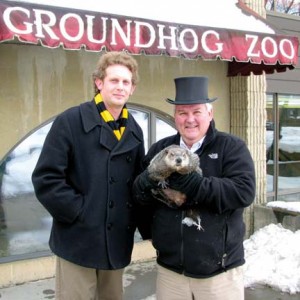TOM CHAPIN ’96

Punxsutawney Phil works only one day a year, but it’s enough to put his hometown on the map.
“People know where Punxsutawney is, and it’s because of Groundhog Day,” says Tom Chapin ’96, the editor of the town’s daily, the Punxsutawney Spirit.
For this Pennsylvania mining and factory town, Groundhog Day is the big day of the year. The town’s population increases fourfold. Local motels are filled. Cash registers ring. The newspaper prints extra copies and picks up extra advertising. A fireworks display lights up the midwinter night. News crews arrive from around the world. “Last year, I met a TV reporter from Russia,” Chapin says.
There are lots of groundhogs, but Phil is special. He predicts when winter will end: if he sees his shadow, as he did this year, we’re in for six more weeks of winter. If he doesn’t, look for an early spring.
Phil has been famous for quite a while. But in the old days his pronouncement rated a story in the newspaper and perhaps a brief mention on the evening news. Then came Bill Murray’s 1993 movie Groundhog Day. “It’s never been the same since,” says Chapin, who first wrote about Groundhog Day for The Campus. “Before the movie, they would get crowds of 1,000. After the movie came out, we started getting 30,000 people. If you tried to get a room for Groundhog Day now, you couldn’t do it. They’re pretty much booked a year in advance.”
The animal that inspires all of this lives a quiet life with three other groundhogs in the children’s section of the public library. On every day but one, his life is predictable: he eats and sleeps. But on the evening of February 1, Phil is taken out to Gobbler’s Knoll, a mile or so south of town, and put in a stump to spend the night in preparation for his next-day duties.
The following morning, the crowd gathers and the members of the Groundhog Club arrive in top hats and tuxedos. Phil’s handlers put him atop the stump, and the Groundhog Club’s president stoops to hear Phil’s pronouncement in “groundhogeese.” Two scrolls have been prepared in advance. After Phil has spoken, the proper scroll is selected, the prediction is read, and an enormous cheer goes up. “It’s a lot like a rock concert,” says Chapin. “Except the people are better behaved, and there’s a groundhog involved.”
Chapin starts preparations for Groundhog Day coverage a month in advance. It’s a lot of extra work for the Spirit’s staff of six and a half, which puts out a morning paper every day but Sunday. But Chapin isn’t complaining, and when the big day arrives, he covers it himself. The weather may be nasty, the skies overcast, but no matter. He sits there and freezes along with everyone else, waiting for Phil’s pronouncement. “It’s a chance to shake off the winter blues,” he says. “I love it.”
— DOUG McINNIS









